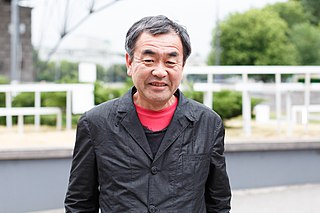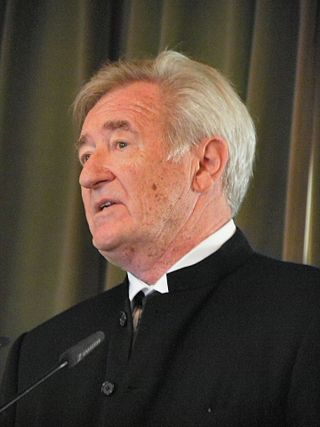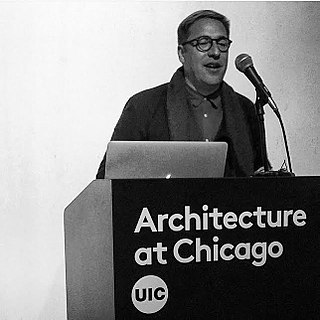Related Research Articles

Walter Burley Griffin was an American architect and landscape architect. He designed Canberra, Australia's capital city, the New South Wales towns of Griffith and Leeton, and the Sydney suburb of Castlecrag.

The University of Wisconsin–Milwaukee is a public urban research university in Milwaukee, Wisconsin. It is the largest university in the Milwaukee metropolitan area and a member of the University of Wisconsin System. It is also one of the two doctoral degree-granting research universities and the second largest university in Wisconsin.
Environmental psychology is a branch of psychology that explores the relationship between humans and the external world. It examines the way in which the natural environment and our built environments shape us as individuals. Environmental psychology emphasizes how humans change the environment and how the environment changes humans' experiences and behaviors. The field defines the term environment broadly, encompassing natural environments, social settings, built environments, learning environments, and informational environments. According to an article on APA Psychnet, environmental psychology is when a person thinks of a plan, travels to a certain place, and follows through with the plan throughout their behavior.
Ken Yeang is an architect, ecologist, planner and author from Malaysia, best known for his ecological architecture and ecomasterplans that have a distinctive green aesthetic. He pioneered an ecology-based architecture, working on the theory and practice of sustainable design. The Guardian newspaper (2008) named him "one of the 50 people who could save the planet". Yeang's headquarters is in Kuala Lumpur (Malaysia) as Hamzah & Yeang, with offices in London (UK) as Llewelyn Davies Ken Yeang Ltd. and Beijing (China) as North Hamzah Yeang Architectural and Engineering Company.

Kengo Kuma is a Japanese architect and emeritus professor in the Department of Architecture at the University of Tokyo. Frequently compared to contemporaries Shigeru Ban and Kazuyo Sejima, Kuma is also noted for his prolific writings. He is the designer of the Japan National Stadium in Tokyo, which was built for the 2020 Summer Olympics. He is married to architect Satoko Shinohara, and they have one son, Taichi, also an architect. He is an advisor for Kitakyushu-city in Japan.

Daryl Sanders Jackson is an Australian architect and the owner of an international architecture firm, Jackson Architecture. Jackson also became an associate professor at University of Melbourne and Deakin University.
Amos Henry Hawley was an American sociologist. Hawley studied extensively how human populations interacted with their changing environments along with the growth of populations. He focused his studies on the behavior of populations in terms of organization, development, and change over space and time.
Atelier Bow-Wow is a Tokyo-based architecture firm, founded in 1992 by Yoshiharu Tsukamoto and Momoyo Kaijima. The firm is well known for its domestic and cultural architecture and its research exploring the urban conditions of micro, ad hoc architecture.
Robert John Adams is an Australian architect and urban designer based in Melbourne. He is currently working part-time as City Architect and previously as the Director of City Design at the City of Melbourne, Australia. He won multiple awards as the leader of the revitalisation of the Melbourne central business district and surrounds, helping to create a vibrant city streetscape with innovative design features.

Frederick Romberg,, , was a Swiss-trained architect who migrated to Australia in 1938, and became a leading figure in the development of Modernism in his adopted city.
The University of Wisconsin–Milwaukee is a doctoral-degree granting public research university that consists of 14 colleges and schools, and 70 academic centers, institutes and laboratory facilities. It offers a total of 180 degree programs, including 94 bachelor's, 53 master's and 32 doctorate degrees. The School of Freshwater Sciences is the only graduate school of freshwater science in the U.S. and the third in the world. The School of Architecture and Urban Planning, the College of Nursing and the College of Health Sciences are the largest in Wisconsin.

Landscape and Urban Planning is a monthly peer-reviewed academic journal published by Elsevier. It covers landscape science, urban and regional planning, landscape and ecological engineering, landscape and urban ecology, and other practice-oriented fields. The editors-in-chief are Joan I. Nassauer and Peter H. Verburg.
Corbett Marshall Lyon is an Australian architect, art patron and academic who lives and works in Melbourne. He is a founding director of Melbourne architectural firm Lyons. With partners Carey Lyon, Cameron Lyon, Neil Appleton, Adrian Stanic and James Wilson he has designed many award-winning institutional and public buildings in Australia.

Wojciech Grzegorz Leśnikowski, was a Polish–American architect, writer and educator. He oversaw and participated in the design and construction of numerous large-scale architectural projects around the world.
Graeme Butler is a heritage architect who has practiced in Melbourne, Australia for near to 40 years. He is principal of the heritage firm Graeme Butler & Associates, and author of many urban conservation and heritage studies and the authority on the Californian bungalow in Australia, which has been described as ...the quintessential work on the form.

JKMM Architects is a Finnish architectural firm. Asmo Jaaksi, Teemu Kurkela, Samuli Miettinen and Juha Mäki-Jyllilä established JKMM Architects in 1998. They started their studies in the middle of eighties. From the beginning, architectural innovation has been the driving force of their work. Studio's design approach reflects Scandinavian values and aesthetics. Their goal is to make architecture with exceptional architectural and technical quality. Over the years JKMM has grown and it employs over 80 professionals. They operate actively in various areas and scales of architecture designing buildings, interiors, furniture, urban environments as well as renovations.

Elizabeth Grant CF was an Australian architectural anthropologist, criminologist and academic working in the field of Indigenous Architecture. She was a Churchill Fellow and held academic positions at The University of Adelaide, as Associate Professor of Architecture and Urban Design at RMIT University's RMIT School of Architecture and Design, Adjunct Professor at the University of Canberra and the University of Queensland. She researched, wrote, and was an activist focused on architecture and design with Indigenous peoples as architectural practice and a social movement, and the observance of human rights in institutional architecture. Her expertise in Indigenous housing and homelessness, design for Indigenous peoples living with disability, and indigenising public places and spaces made her a regular guest on the Australian Broadcasting Corporation's Radio National and ABC Local Radio. She wrote and reviewed architectural projects for architectural magazines such as Architecture Australia, the journal of the Australian Institute of Architects, and the Australian Design Review.

Peter Zellner is an American/Australian designer, professor, author, urban theorist and educator. He is the principal of ZELLNERandCompany. Between 2014 and 2015 he led AECOM's Los Angeles design studio. His work ranges from large scale city planning projects to residential design.
Grace La is a first generation, Korean-American designer, Chair of the Department of Architecture and Professor of Architecture at the Harvard University Graduate School of Design (GSD), and Principal of LA DALLMAN. Co-founded with James Dallman, LA DALLMAN is a design firm recognized for the multidisciplinary integration of architecture, infrastructure, and landscape, with offices in Boston, MA and Milwaukee, WI. La previously served as the Chair of the Harvard GSD's Practice Platform and served as GSD's Director of the Master of Architecture Programs (2014–17).
Paul Christopher Memmott is an Australian architect, anthropologist, academic and the Director of the Aboriginal Environments Research Centre at the University of Queensland. He is an expert on topics related to Indigenous architecture and vernacular architecture, housing, homelessness and overcrowding.
References
- 1 2 Ingold, Tim (2002) Companion Encyclopedia of Anthropology, Taylor & Francis
- ↑ TU Darmstadt: "Public Lecture of the Australian / American Architectural anthropologist Prof. Amos Rapoport" Archived 2016-03-04 at the Wayback Machine , 2010, retrieved 9 August 2015
- ↑ Caves, R. W. (2004). Encyclopedia of the City . Routledge. pp. 556. ISBN 9780415252256.
- 1 2 Rapoport, Amos (1990) "Science and the Failure of Architecture" in Altman, I. & Christensen, K. Environment and behavior studies: emergence of intellectual traditions, Plenum Press